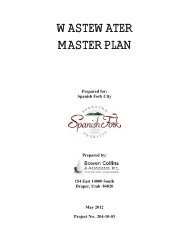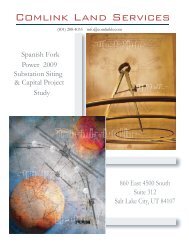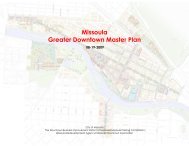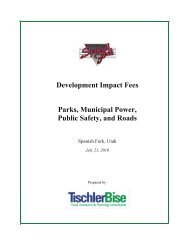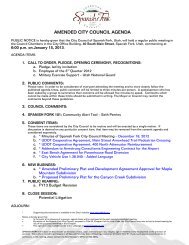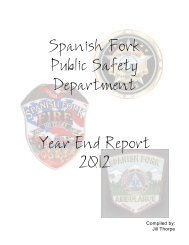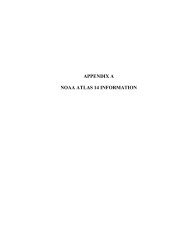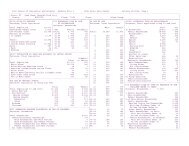Downtown Design Guidelines - Pleasant Grove City
Downtown Design Guidelines - Pleasant Grove City
Downtown Design Guidelines - Pleasant Grove City
You also want an ePaper? Increase the reach of your titles
YUMPU automatically turns print PDFs into web optimized ePapers that Google loves.
<strong>Pleasant</strong> <strong>Grove</strong> <strong>Downtown</strong> Village<br />
<strong>Design</strong> Standards and <strong>Guidelines</strong><br />
<strong>Downtown</strong> history<br />
<strong>Pleasant</strong> <strong>Grove</strong> was settled in 1850 as<br />
a Mormon frontier farming community.<br />
With the first Indian troubles in 1853,<br />
the settlers quickly located inside a<br />
surveyed Spanish style fort. Growth<br />
beyond the fort’s containment<br />
justified the division of the fort’s<br />
central corral into four blocks. Over<br />
time, the closely and evenly set<br />
houses around the inside perimeter<br />
of the fort were left undisturbed<br />
while the west blocks grew into the<br />
town’s community, civic, cultural and<br />
commercial center. <strong>Pleasant</strong> <strong>Grove</strong><br />
is unique in the respect that it is the<br />
only known town that developed<br />
within fort boundaries, in contrast to<br />
the Mormon cultural pattern of<br />
deliberately surveyed township sites<br />
with wide streets.<br />
The marked four corners of the fort<br />
are within the historic district, and<br />
one original fort house still stands back<br />
from the street where it stood in line<br />
with other fort houses. The roads that<br />
ran between the houses and the<br />
central corral are still recognizable by<br />
their width on Main and 200 East. On<br />
Center Street and Battle Creek Drive<br />
(200 South) they narrow where later<br />
developed streets left the fort area.<br />
Four standing buildings mark the<br />
cultural and civic growth as well as the<br />
town’s building materials: 1) the 1996<br />
restored adobe Old Bell School (the<br />
oldest standing school building in Utah)<br />
at 65 South 100 East, 2) the 1869 soft<br />
rock (unique to this area) United Order<br />
Hall at 25 East 100 South, 3) the 1886<br />
soft rock <strong>Pleasant</strong> <strong>Grove</strong> <strong>City</strong> Hall at<br />
105 South 100 East, and 4) the 1909<br />
Orpheus Dance Hall at 41 East 200<br />
South.<br />
Two very early restored hotels are<br />
within the district, the Mayhew House<br />
at 214 South Main, and the Beers<br />
Hotels at 65 North 100 East, built of<br />
oversize adobe. Also, a 1920’s<br />
seminary building at 50 East 200<br />
South marks the presence of the<br />
LDS religion, whose people<br />
pioneered the town and persisted.<br />
Very early houses intertwined with<br />
business and civic buildings (an<br />
early building pattern) are now<br />
commercial outlets, retaining the<br />
historic character of the street as<br />
they add to the business progress<br />
on the town. Early hall-parlor and<br />
cross-wing house types, and after,<br />
large block-form houses with<br />
projecting windows and eye-lid<br />
dormers, unique to Utah County<br />
during the turn of the 20 th Century<br />
era, are frequent. These and later<br />
styles (Bungalow and English Cottage)<br />
still predominately stand out in the<br />
residential area, although some recent<br />
houses intermingle. Two Art Deco<br />
buildings represent the early 1940’s.<br />
Adopted June 7, 2011 4



